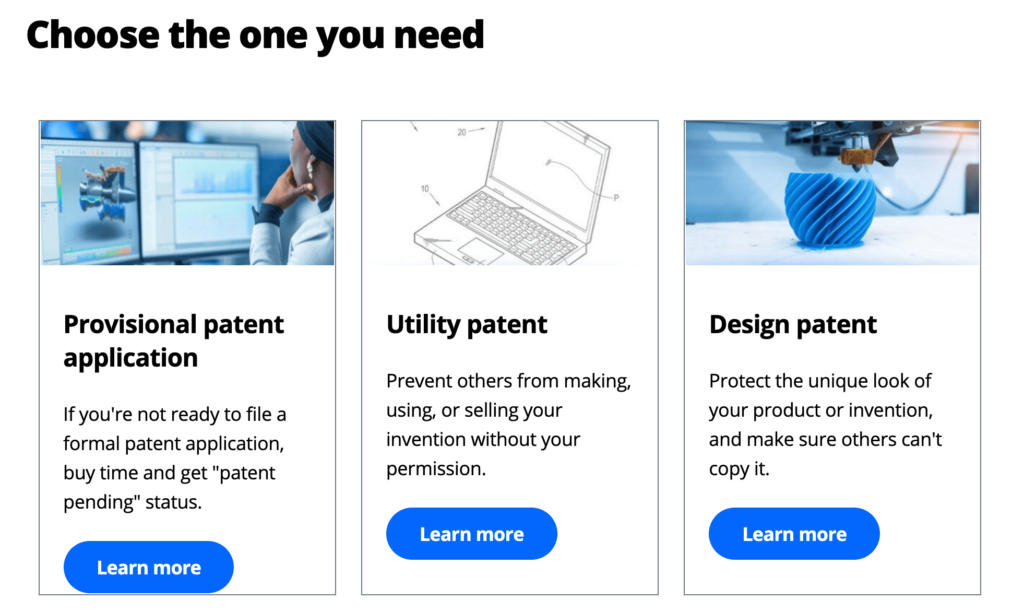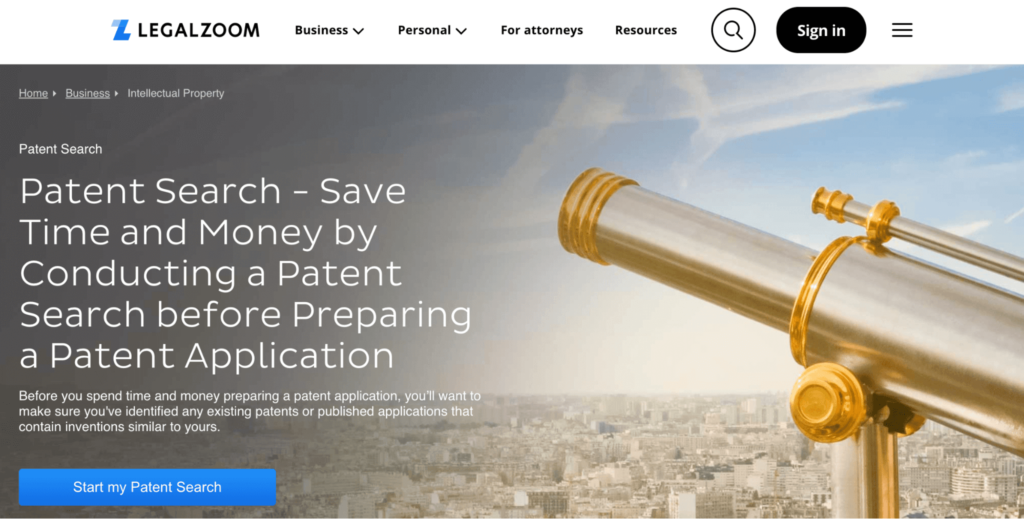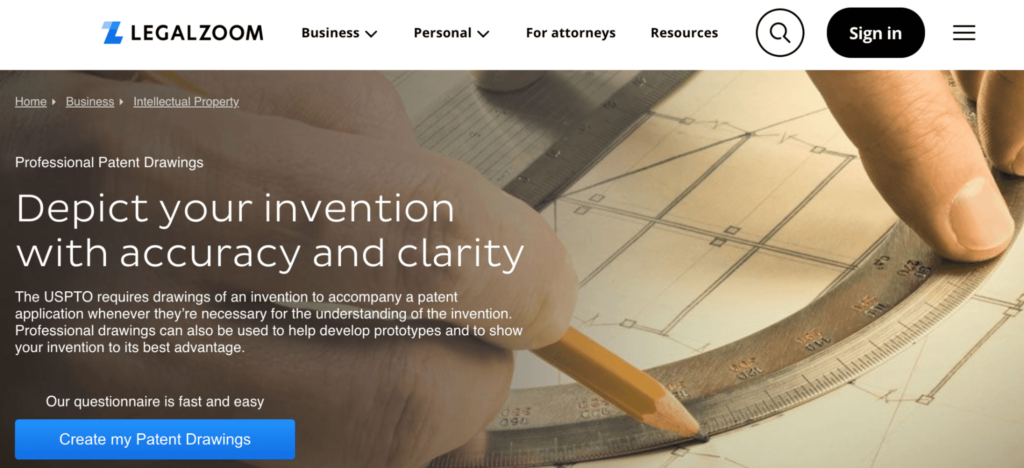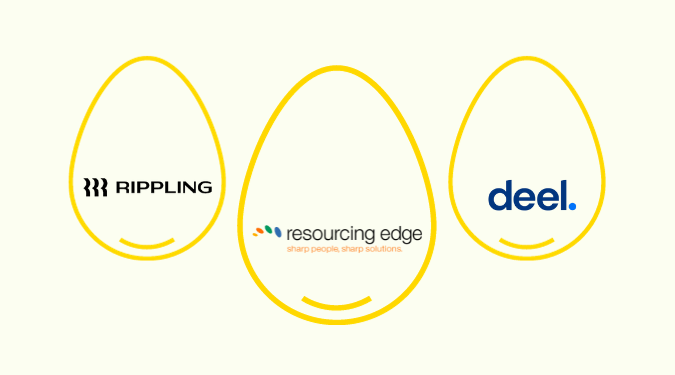Want help protecting your idea with a patent? We recommend LegalZoom for fast, straightforward service.
A patent is usually the difference between inventors who make a fortune on their ideas and those who don’t.
If you don’t file a patent application (or someone else files before you), then there is very little you can do to prevent other people from profiting of your great idea.
We’ll walk you through the entire process in this post. Full review and approval of your patent may take 2 years, so it’s important to get started as soon as possible.
Patent an Idea with an Online Service
Online legal services will walk you through the patent registration process. Our recommendations can help you file all the important paperwork quickly and correctly.
- Rocket Lawyer – Best for most
- Bizee (formerly Incfile) – Best for business formation
- LegalZoom – Best for flat fees and versatility
- UpCounsel – Best for complex legal needs
- Avvo – Best for free legal advice
- LegalMatch – Best for locating an attorney near you
We’ll use Legal Zoom in this post as an example of how you can patent an idea. Pricing, reviews, and additional offerings are covered in our review of the best online legal services.

Why Patenting an Idea is Worth It
Patents are crucial for safeguarding a new invention. You can use a patent to legally protect products, designs, or processes that meet specific criteria. Usually, a patent can protect your idea for up to 20 years.
Once the patent has been granted, you’ll have the exclusive rights to make, use, or sell an invention. This essentially gives you a monopoly-like advantage over your idea.
You can use a patent to stop competitors from doing things that infringe upon your patent. Or you could potentially sell the rights to use your invention to other businesses, securing significant profits just for the idea.
If someone breaches your patent, you can potentially sue them for a significant amount of money. However, it’s worth noting that the legal fees associated with bringing someone to court for a patent violation can be expensive.
If you have an idea you want to protect, but you don’t have all the application materials ready, you can file for a provisional patent, which will protect your idea for a year while you iron out the details.
The Investment Needed to Patent an Idea
Obtaining a patent for your idea isn’t cheap. As you’ll soon discover, you actually need to create a prototype for your patent before you can file anything to protect it. The investment required here varies significantly depending on the complexity of your idea.
It usually takes between 18 and 24 months to receive a patent in the United States. You’ll likely need to invest at least $10,000 to $25,000 in this process.
Patenting an idea is much easier if you’re using an online legal service like LegalZoom. The service walks you through the process of obtaining a utility patent or a design patent. They offer consultations with a USPTO-registered patent attorney, patent searches, technical illustration assistance, application preparation, and electronic filing.
You can even use LegalZoom to file a provisional patent, which defends your idea against the competition while you work on the paperwork. This lets you market your idea as “patent pending” for a year before the actual patent is officially obtained. LegalZoom’s provisional patent services start at just $199 plus filing fees.
LegalZoom utility patent services and design patent services start at $699 and $899, respectively. These services are designed to help you with every aspect of the patent process in order to get your idea across the finish line.

6 Steps to Patent an Idea
Ready to patent your idea? Follow the step-by-step tutorial below.
Step 1 – Verify the Idea is Eligible For a Patent
Before you proceed through a lengthy and expensive process, you need to make sure that your idea meets the eligibility requirements for a patent.
Not every idea or invention can be patented. You can refer to the United States Patent and Trademark Office (USPTO) for the complete requirements, but here’s a general summary to steer you in the right direction:
- All patents must be novel and non-obvious, meaning that the idea or invention must be completely new.
- If someone else has invented your idea before or described it in a patent application, then your idea won’t be eligible for a patent.
- You cannot combine two known or obvious things in a patent. There must be something unique about your idea or a proprietary way you’re combining them.
- An idea for an invention can’t be too abstract. For example, let’s say you want to patent a mathematical formula. If the formula isn’t tied directly to an application or process, the idea is not patentable. Your concept must have a real-world use and application to be eligible.
- Natural discoveries are not eligible for a patent. For example, if you’re hiking and find a new animal in the woods that’s never been discovered before, you can’t patent it.
- The use of your patent must be clearly defined and non-speculative. If you use a potent plant extract to formulate an anti-aging cream, you can’t speculate that higher doses of the extract will cure cancer. You’ll need to define the scope of how that works to obtain a patent on the latter.
Assuming your idea meets the criteria so far, then you can move on to see what type of patent your idea qualifies for. In the United States, there are three different types of patents that can be issued:
- Utility Patent — Roughly 90% of all patents issued are utility patents. These are for inventions of a process, machine, compositions of matter, or manufacturing systems that are new and useful. You can also obtain a utility patent for improvements to an existing process.
- Design Patent — Design patents must have “surface ornamentation” of an object. To obtain this type of patent, the design and object must be inseparable. In short, utility patents protect the way an idea works, and design patents protect the way it looks.
- Plant Patent — Plant patents are issued to new and distinctive plants that can be asexually reproduced. This means that rather than the plant reproducing with a seed, you can propagate it by cutting or grafting the plant. Asexual reproduction is the proof required that the person applying for the patent can actually reproduce the plant.
The final part of verifying the idea’s eligibility is by running a patent search. This ensures there isn’t an existing patent on your idea or any pending applications that are too similar to yours.
LegalZoom offers patent search services starting at just $299.

Step 2 – Keep a Detailed Record of Everything
As previously mentioned, an idea alone isn’t enough for a patent. You might also need to back up the fact that the idea is uniquely yours.
To do this, you should record your entire thought process in a journal or a notebook along with any other evidence you have. From raw notes to sketches, corrections, mistakes, and more, all of this could help defend that you’re the one who came up with this new idea.
Each page of your notes and record should be signed and dated. If possible, have one or two witnesses sign the pages as well.
Having other people sign your notes means you’re exposing your idea. While it would be nice to trust those people, you should have them sign NDAs (non-disclosure agreements) to legally prevent them from sharing what they’ve seen.
This is especially crucial if you’re having other people working on the concept with you.
Let’s say you have employees or contractors performing tasks on your behalf. The NDA and contract should clarify that any work done toward your idea is owned by you and you alone. Their role in the process doesn’t give them the rights toward the patent or its profits.
You know that your idea is your intellectual property, but can you prove it? The US Chamber of Commerce has a helpful guide for individuals and businesses that want to know how to protect their intellectual property.
Services like LegalZoom is also offer a wide range of contracts and templates, including NDAs. This is a great way for inventors to ensure that their ideas are protected.
Step 3 – Make a Prototype
You should have a prototype or model of your idea prepared before you file the paperwork for a patent. Again, you cannot just patent an idea—there needs to be more.
The prototype should be something tangible that you could show to somebody. For example, if your idea is an invention of something that you want to license or present to investors for funding, you’d need to give them more than an idea.
In addition to the requirements for the patent itself, making a prototype can help with your idea. By bringing this idea to life, you might discover flaws or areas that need improvement that wasn’t considered when the idea was just a thought or words on a sheet of paper.
The best way to create a prototype is by starting with an accurate drawing. The images will also be used during the patent application process.
Drawing your idea for a patent requires more than just an amateur sketch. It’s highly recommended that you use a professional patent drawing service.

Staring at just $399, you can use LegalZoom for this process.
All you need to do is fill out a simple online questionnaire about your idea. Then upload your sketches, photos, and images of your idea that the professional artist will use for inspiration. Then you need to just sit back and wait for LegalZoom to send you the finalized technical drawings of your idea.
Step 4 – Apply For a Provisional Patent
Some of you might have a great idea, but you’re not quite ready to defend it with a patent application just yet. If you need some additional time to prepare the application, you can apply for a provisional patent instead.
With a provisional patent application, you can protect your idea for up to one year while you finalize the details of your official application.
Essentially, this holds your place in line with the USPTO, preventing anyone else from obtaining rights to the idea before you.
You can use LegalZoom to file a provisional patent application. Starting at just $199 plus filing fees, it’s the easiest way to get a provisional patent online.
The service has been used to grant “patent pending” status more than 65,000 times, so you know it’s a reputable service you can rely on.
Some of the information required for this application includes:
- Title of the idea and invention
- Name and address of the inventor or inventors
- Official correspondence address
- Summary of the idea
- Background of the idea
- A detailed description of the idea
- US government interest/ownership (if applicable)
Drawings are optional, but they’re highly recommended to ensure things go smoothly. That’s why we recommend getting professional technical drawings made during the prototype process in the previous step.
Step 5 – Hire a Patent Attorney
With something as important as a patent, it’s always in your best interest to hire a lawyer.
Remember, this is a long and expensive process. You don’t want to spend two years of your life and up to $25,000 just to have the application rejected by the USPTO.
A patent attorney will help ensure that your idea is patentable and helps walk you through everything else to ensure its validity. Patents are useless if you can’t defend your idea in court against someone infringing on your patent. An attorney will help make sure that the patent is bulletproof.
LegalZoom offers an attorney consultation during its two-step patent filing process. You’ll get to speak with a USPTO-registered agent over the phone to discuss your idea. That’s the first step of the process that also includes technical illustrations and an optional patent search—starting at $699.
In addition to the attorney consultations available with LegalZoom’s patent services, you can also hire an independent attorney directly through this platform.

Step 6 – File Your Patent Application
Now you need to submit and file the patent application. If you followed each step above, you’ll be ready for this when the time comes.
Again, if you’ve just filed a provisional patent and you’re still working on the idea, the official patent application will have to wait. You’ll have up to a year to work on your idea during the “patent pending” stage, but obviously, the sooner you can apply, the better.
You can always file your patent application on your own through the USPTO website. The instructions are relatively easy to follow.
But we recommend using the attorney you retained in the previous step to help with this process. That’s another reason why LegalZoom is so useful for patenting an idea.
If you sign up for LegalZoom’s two-part patent service, the application itself is part two.
You’ll have a follow-up consultation with a USPTO-registered attorney who will prepare up to two drafts of the application. That attorney will also file the completed application electronically directly with the USPTO.
Next Steps
It’s a waiting game after the application has been filed. Patent approval can take up to two years after you’ve applied. The USPTO offers extensive guidance on what to expect throughout the application process, how to maintain your patent after approval, and where to go for assistance.
In the meantime, you should consider starting a business if you haven’t done so already. You can use the company to create, sell, or license your idea. Check out our step-by-step guide on how to create a business for further instructions.
Our brand-building guide is another useful resource for helping you market your idea, even while it’s in the “patent pending” stages.














